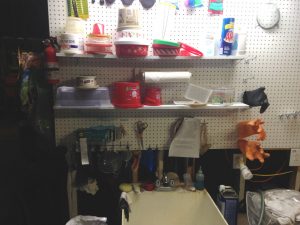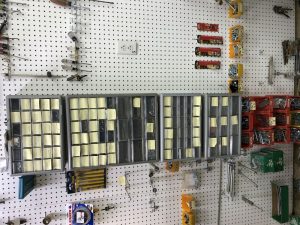No Southern-fried Southern boy wants to be called a Yankee, but we share the characteristics of shrewdness and thrift. Thus, each month we include a money-saving tip. It’s OK if you call me “cheap.”
You want something free? Well, almost free.
If you eat whipped butter, margarine, Cool Whip, or other foodstuffs that come in plastic tubs, you can make use of those tubs in the shop and they won’t cost you an additional dime.
Now, if you, like me, don’t eat any of those above items, you, like me, probably know someone who does. It’s not hard to talk them into saving some containers.
What are they good for? A kazillion uses! (Sorry, Steve.)
Probably the thing I use them for most is parts washing.

Over the utility sink turned out to be the best place for some shelves to store my “butter containers.” If I need to wash something, there is one close by. If I need the lid, I know right where it is.
From cleaning paint brushes to wheel bearings, they’re impervious to every solvent I’ve ever used, which means if you’re cleaning parts in batches you can use the same cleaner repeatedly until it’s dirty.
They’re neither air-tight nor water-tight, so you shouldn’t store liquids for the long term.
Speaking of liquids, they’re great for decanting from a large container of finish into one you can work from. If you need to go to the door to sign for a UPS package, and you’re coming right back, you can pop on the top to slow drying and evaporation. However, don’t plan to store finishes in these containers; the lids don’t fit securely. Over a short amount of time oxygen will enter and ruin the finish, and, if it falls from a height, finish is going everywhere.
Component storage is a good use for the long and short term. If you’ve taken a piece apart for restoration and you want to save
all the screws, bolts, nuts, washers and hardware, an old butter container will keep them together with your project until you’re ready to reassemble. Most aren’t see-through, but, with a proper label, or even a temporary Post It Note, you can store any sort of small hardware. Personally, I prefer organizers with drawers, but these still beat my Uncle Sam’s old system of “throw everything into a coffee can.”

These organizers with plastic, see-through drawers won’t break the bank, either. I have screws in one, nails in another, nuts and bolts in the third.
Jim Randolph is a veterinarian in Long Beach, Mississippi. His earlier careers as lawn mower, dairy farmer, automobile mechanic, microwave communications electronics instructor and journeyman carpenter all influence his approach to woodworking. His favorite projects are furniture built for his wife, Brenda, and for their children and grandchildren. His and Brenda’s home, nicknamed Sticks-In-The-Mud, is built on pilings (sticks) near the wetlands (mud) on a bayou off Jourdan River. His shop is in the lower level of their home. Questions and comments on woodworking may be written below in the comments section. Questions about pet care should be directed to his blog on pet care, www.MyPetsDoctor.com. We regret that, because of high volume, not all inquiries can be answered personally.


I really enjoyed your storage solutions These containers are wonderful and, in spite of my wife’s objections that I clog the dishwasher, I have a drawer full of sour cream, cottage cheese tubs and more that I use almost daily.
PS: The Dekalb Farmer’s Market puts many of their deli products in see through tubs!
I am into woodturning, mostly stuff that will fit on my mini-lathe. I use containers from our local Chinese restaurant and containers from Gelotto sold in our local Aldi store. They are close to the same size, fit on a shelf nicely, and are used for separate projects and inventory and to hold strips of sandpaper to keep things neat. And it’s a tasty way to acquire storage containers.